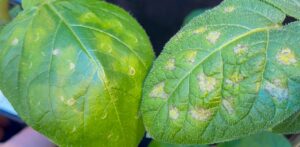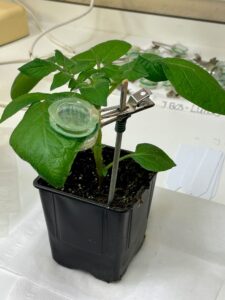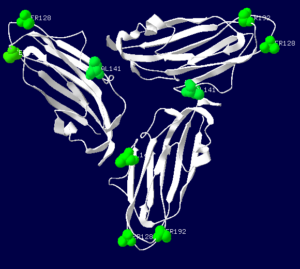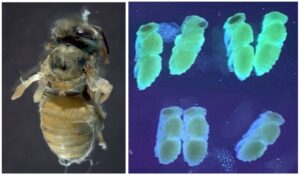Biography
I am a molecular virologist with interests in virus-host interactions in plants and invertebrates. My work with virus discovery and evolution started in 1990s in and continued through all my research years. For a decade starting from mid 1990s, I focused on the mechanisms of virus movement within plants. More recent work with plant viruses included the mechanisms of regulation and genetic control of antiviral RNAi. My invertebrate virus research started in 2007 and which was carried out in the University of Warwick and in the US Department of Agriculture focused on the viruses of aphids and honey bees, in particular on the commensal relationships between aphids and their viruses, and on the role of viruses of in honey bee colony losses. After joining the James Hutton Institute in the autumn 2023, I am working with potato viruses and on the development of approaches of their control, which will exploit antiviral resistance genes and RNAi-based antiviral defenses.
Research
Viruses are widespread in the natural and managed ecosystems and affect their hosts’ health, physiology and survival. Viruses could significantly reduce yield and quality of crops, therefore data on virus diversity, understanding their interactions with hosts and vectors, and antivirus responses are essential for development of novel sustainable approaches preventing virus diseases in crops. My current projects focus on viruses infecting potato, an economically important crop in Scotland and worldwide.
My study of the mechanisms of resistance to Potato leafroll virus (PLRV) operating in several potato cultivars includes characterization of infection dynamics in these plants, analysis of vertical transmission through tubers, and horizontal transmission by aphid vectors. Genomic analysis of the PLRV resistant potato varieties is being carried out to identify and characterize antivirus resistance with an aim to identify genetic basis of resistance and to explore possibility to introduce PLRV resistance gene(s) to commercial potato varieties.



Viruses can infect both potato crop and wild plant species which could act as infection reservoirs and can be dispersed by invertebrate vectors. Therefore, obtaining a complete understanding of the natural life cycles of the potato viruses requires virome analysis not only in cultivated potato crop, but also in wild reservoir plant species and aphid vectors of PLRV. Quasispecies of potato viruses, such as PLRV and Potato virus Y may include variants with potentially different biological properties, some of which could be present as minor components of virus populations. High-throughput sequencing allows identification of such variants which is essential for the development of specific antiviral RNAi therapeutics and monitoring of potential resistance breaking virus strains. My research aims to comprehensively characterize of viromes of potato plants, aphids, and wild reservoir plants by high-throughput sequencing to obtain insight into the circulation and spread of potato viruses with the aim of developing agricultural practices that minimize the spread of viruses in potato.
Past research
My work with plant virus discovery, sequencing and analysis of plant virus evolution started in 1990s in and continued through all my research years. For a decade starting from mid 1990s, since joining Scottish Crop Research Institute, my work focused on the mechanisms of virus movement within plants. A highlight of this research was a discovery of a long-distance movement proteins of umbraviruses which facilitate phloem long-distance movement of viral RNA, and demonstration of the involvement of the host nucleolus and nucleolar protein, fibrillarin, in this process.
More recent work with plant viruses included the mechanisms of regulation and genetic control of antiviral RNAi. I have developed a novel vector based on the genome of Turnip crinkle virus, which was used to characterize viral suppressors of RNA and unravel the mechanisms of cell-to-cell and long-distance spread of RNAi signal molecules within plants.
My invertebrate virus research initially focused on the viruses of aphids which resulted in the discovery of a novel phenomenon of the virus-induced winged morph development and dispersal in aphids, which suggested commensal relationships between the virus and its aphid host and indicated that pathogens may play a role in ‘normal’ insect physiology and in functioning of ecological systems. More recently, I commenced work on RNA viruses of honey bees associated with colony losses and threatening pollination service provision. This work included analysis of honey bee virus population structure using high-throughput sequencing approaches, design and the use of reverse genetic system for Deformed wing virus (DWV), the main virus pathogen of honey bees, to investigate interaction between virus genotypes in virus populations, antivirus RNA defenses and virus transmission routes.

Publications
Samarskaya, V.O., Ryabov, E.V., Gryzunov, N., Spechenkova, N., Kuznetsova, M., Ilina, I., Suprunova, T., Taliansky, M.E., Ivanov, P.A., Kalinina, N.O. (2023) The temporal and geographical dynamics of potato virus Y diversity in Russia. International Journal of Molecular Sciences. 24: 14833.
Ryabov, E.V., Nearman, A.J., Nessa, A. Grubbs, K., Sallmann, B., Fahey, R., Wilson, M.E., Rennich, K.D., Steinhauer, N., Fauvel, A.M., Chen, Y., Evans, J.D., vanEngelsdorp, D. (2023) Apis mellifera Solinvivirus-1, a Novel Honey Bee Virus That Remained Undetected for over a Decade, Is Widespread in the USA. Viruses. 15:1597.
Cook, S., Ryabov, E.V., Becker, C., Rogers, C.W., Posada-Florez, F., Evans, J,D., Chen, Y.P. (2023) Deformed wing virus of honey bees is inactivated by cold plasma ionized hydrogen peroxide. Frontiers in Insect Science 3:1216291
Palmer-Young, E.C., Ryabov, E.V., Markowitz, L., Boncristiani, D.L., Grubbs, K., Pawar, A., Peterson, R., Evans, J.D. (2023) Host-driven temperature dependence of Deformed wing virus infection in honey bee pupae. Communications Biology 6: 333.
Lamas, Z.S., Solmaz, S., Ryabov, E.V., Mowery, J., Heerman, M., Sonenshine, D., Evans, J.D., Hawthorne, D.J. (2023) Promiscuous feeding across multiple honey bee hosts amplifies the vectorial capacity of Varroa destructor. PLoS Pathogens. 19: e1011061.
Ryabov, E.V., Posada-Florez, F., Rogers, C.W., Lamas, Z.S., Evans, J.D., Chen, Y., Cook, S.C. (2022) The vectoring competence of the mite Varroa destructor for Deformed wing virus of honey bees is highly dynamic and affects survival of the mite. Frontiers in Insect Science 2: 931352
Miranda, J.R., Brettell, L.E., Chejanovsky, N., Chen, Y., Childers, A.K., Dalmon, A., Deboutte, W., de Graaf, D.C., Doublet, V., Gebremedhn, H., Genersch, E., Gisder, S., Granberg, F., Haddad, N.J., Kaden, R., Manley,R., Matthijnssens, J., Meeus, I., Migdadi, H., Milbrath, M.O., Mondet, F., Remnant. E.J., Roberts, J.M.K., Ryabov, E.V., Sela, N., Smagghe, G., Somanathan, H., Wilfert, L., Wright, O.N., Martin, S.J. , Ball, B.V. (2022) Cold case: The disappearance of Egypt bee virus, a fourth distinct master strain of deformed wing virus linked to honeybee mortality in 1970’s Egypt, Virology Journal 19: 12.
Evans, J.D., Banmeke, O., Palmer-Young, E. C., Chen, Y., Ryabov E.V. (2021) Beeporter: tools for high-throughput analyses of pollinator-virus infections. Molecular Ecology Resources 22: 978-987.
Posada-Florez, F., Lamas, Z.S., Hawthorne, D., Chen, Y., Evans, J.D., Ryabov, E.V. (2021) Pupal cannibalism by worker honey bees contributes to the spread of Deformed wing virus. Scientific Reports 11: 8989.
Tauber, J.P., McMahon, D., Ryabov, E.V., Kunat, M., Ptaszynska, A.A., Evans, J.D. (2021) Honeybee intestines retain low yeast titers, but no bacterial mutualists, at emergence. Yeast. 2021: 1–13.
Posada-Florez, F., Ryabov, E.V, Heerman, M.C., Cook, S.C., Chen, Y., Evans, J.D., Sonenshine, D.E. (2020) Varroa destructor mites vector and transmit pathogenic honey bee viruses acquired from an artificial diet. PLoS ONE 15: e0242688.
Ryabov E.V., Christmon, K., Heerman, M.C., Posada-Florez, F., Harrison, R.L., Chen, Y., Evans, J.D. (2020) Development of a honey bee RNA virus vector based on the genome of Deformed wing virus. Viruses 12: 374.
Gusachenko, O.N., Woodford, L., Balbirnie-Cumming, K., Ryabov, E.V., Evans, D.J. (2020). Evidence for and against deformed wing virus spillover from honey bees to bumble bees: a reverse genetic analysis. Scientific Reports 10: 16847.
Ryabov E.V., Childers, A.K., Lopez, D., Grubbs, K., Posada-Florez, F., Weaver, D., Girten, W., vanEngelsdorp, D., Chen, Y, Evans, J.D. (2019) Dynamic evolution in the key honey bee pathogen deformed wing virus: Novel insights into virulence and competition using reverse genetics. PLoS Biology 17(10):e3000502.
Posada-Florez, F., Childers, A.K., Heerman, M.C., Chen, Y.P., Evans, J.D., Ryabov, E.V. (2019) Deformed wing virus type A, a major honey bee pathogen, is vectored by the mite Varroa destructor in a non-propagative manner. Scientific Reports 9: 12445.
Olendraite, I., Brown, K., Valles, S.M., Firth, A.E. Chen, Y., Guérin, D.M.A. Hashimoto, Y., Herrero, S. de Miranda, J., Ryabov, E. (2019) ICTV Virus Taxonomy Profile: Polycipiviridae. Journal of General Virology.100: :554–555.
Brown, K., Olendraite, I., Valles, S.M., Firth, A.E., Chen, Y., Guérin, D.M.A. Hashimoto, Y., Herrero., S. de Miranda, Ryabov, E. (2019) ICTV Virus Taxonomy Profile: Solinviviridae. Journal of General Virology 100: 736–737.
Chen, W.W., Zhang, X., Fan, Y., Li, B., Ryabov, E. Shi, N., Zhao, M., Yu, Z., Qin, C., Zheng, Q., Zhang, P., Jackson, S., Cheng, Q., Liu, Y., Gallusci, P., Hong, Y., (2018) A genetic network for systemic RNA silencing in plants. Plant Physiology. 176: 2700–2719.
Ryabov, E.V., Childers, A.K., Chen, Y., Madella, S., Ashrafun, A., vanEngelsdorp, D., Evans, J.D. (2017) Recent spread of Varroa destructor virus-1, a honey bee pathogen, in the United States. Scientific Reports 7: 17447.
Ryabov, E.V. (2017) Invertebrate RNA virus diversity from a taxonomic point of view. Journal of Invertebrate Pathology 147: 37-50.
Qin, C., Li, B., Fan, Y., Zhang, X., Yu, Z., Ryabov, E., Zhao, M., Wang, H., Shi, N., Zhang, P., Jackson, S., Tör, M., Cheng, Q., Liu, Y., Gallusci, P., Hong, Y. (2017) Roles of DCL2 and DCL4 in intra- and intercellular antiviral silencing in Nicotiana benthamiana. Plant Physiology 174: 1067-1081.
Valles, S.M., Chen, Y., Firth, A.E. Guérin, D.M.A. Hashimoto, Y., Herrero, S. de Miranda, J., Ryabov, E. (2017) ICTV Virus Taxonomy Profile: Iflaviridae. Journal of General Virology 98: 527.
Valles, S.M., Chen, Y., Firth, A.E., Guérin, D.M.A. Hashimoto, Y., Herrero., S. de Miranda, J., Ryabov, E. (2017) ICTV Virus Taxonomy Profile: Dicistroviridae. Journal of General Virology 98: 355-356.
Ryabov E.V., Fannon, J. M., Moore, J. D., Wood, G. R. and Evans D. J. (2016) The Iflaviruses Sacbrood virus and Deformed wing virus evoke different transcriptional responses in the honeybee which may facilitate their horizontal or vertical transmission PeerJ 4: e1591 1
Ryabov, E.V., Wood, G.R., Fannon, J.M, Moore, J.D., Bull, J.C., Chandler, D., Mead, A., Burroughs, N., Evans, D.J. (2014) A Virulent strain of Deformed wing virus (DWV) of honeybees (Apis mellifera) prevails after Varroa destructor – mediated, or in vitro, transmission. PLoS Pathogens 10: e1004230.
Wood, G.R., Ryabov, E.V., Fannon, J.M., Moore, J.D., Evans, D.J., and Burroughs, N. (2014) MosaicSolver: a tool for determining recombinants of viral genomes from pileup data. Nucleic Acid Research 42: e123.
Wood, G.R., Burroughs, N., Evans, D.J., Ryabov, E.V. (2014) Error correction and diversity analysis of population mixtures determined by NGS. PeerJ 2: e645.
Vanbergen A.J., and the Insect Pollinators Initiative (2013) Threats to an ecosystem service: Multifactorial pressures on insect pollinators. Frontiers in Ecology and the Environment, 11: 251-259.
Bull, J.C., Ryabov, E.V. Prince, G., Mead, A., Zhang, C., Baxter, L.A., Pell, J.K. and Chandler, D.A. (2012) A strong immune response in young adult honeybees masks their increased susceptibility to infection compared to older bees. PLoS Pathogens 8: e1003083.
Qin, C., Shi, N. Gu, M., Zhang, H., Li, B., Shen, J., Mohammed, A., Ryabov, E., Li, C., Wang, H., Liu, Y., Osman, T., Vatish, M., and Hong, Y. (2012). Involvement of RDR6 in short-range intercellular RNA silencing in Nicotiana benthamiana. Scientific Reports 2:467.
Moore, J., Jironkin, A., Chandler, D., Burroughs, N., Evans, D.J., Ryabov, E.V. (2011) Recombinants between Deformed wing virus and Varroa destructor virus-1 may prevail in Varroa destructor-infested honeybee colonies. Journal of General Virology, 92: 156 – 161.
Ryabov E.V., Keane G., Naish, N., Evered, C., Winstanley, D. (2009) A densovirus induces winged morphs in asexual clones of the rosy apple aphid, Dysaphis plantaginea. Proceedings of the National Academy of Sciences of the USA, 106: 8465 – 8470. https://doi.org/10.1073/pnas.0901389106
Shi, Y., Ryabov, E.V., van Wezel, R., Li, C., Jin, M., Wang, W., Fan, Z., and Hong, Y. (2009) Suppression of local RNA silencing is not sufficient to promote cell-to-cell movement of Turnip crinkle virus in Nicotiana benthamiana. Plant Signaling & Behavior (Landes Bioscience) 4:15–22.
Zhou, Y., Ryabov, E., Zhang, X, Hong, Y. (2008) Influence of viral genes on the cell-to-cell spread of RNA silencing. Journal of Experimental Botany 59: 2803-2813.
Jin, M., Li, C., Shi, Y., Ryabov, E., Huang, J., Wu, Z., Fan, Z., Hong, Y. (2008) A single amino acid change in a geminiviral Rep protein differentiates between triggering a plant defence response and initiating viral DNA replication. Journal of General Virology, 89:2636-2641.
Ryabov, E.V. (2007). A novel virus isolated from the aphid Brevicoryne brassicae with similarity to Hymenoptera picorna-like viruses. Journal of General Virology, 88: 2590-2595. https://doi.org/10.1099/vir.0.83050-0
Kim, S.H., MacFarlane, S., Kalinina, N.O., Rakitina, D.V., Ryabov, E.V., Gillespie, T., Haupt, S., Brown, J.W.S., and Taliansky, M. (2007). Interaction of a plant virus-encoded protein with the major nucleolar protein fibrillarin is required for systemic virus infection. Proceedings of the National Academy of Sciences of the USA 104: 11115-11120.
Kim, S.H., Ryabov, E.V., Kalinina, N.O., Rakitina, D.V., Gillespie, T., MacFarlane, S., Haupt, S., Brown, J.W.S., and Taliansky, M. (2007) Cajal bodies and the nucleolus are required for a plant virus systemic infection. The EMBO Journal 26: 2169 – 2179.
Haupt, S., Straoganova, T., Ryabov, E., Kim, S.H., Fraser, G., Duncan, G., Mayo, M. A., Barker, H., Taliansky, M. (2005) Nucleolar localization of potato leafroll virus capsid proteins. Journal of General Virology, 86:2891-286.
Ryabov, E.V., Kim, S.H., and Taliansky, M. E. (2004) Identification of a nuclear localization signal and nuclear export signal of the umbraviral long-distance RNA movement protein. Journal of General Virology, 85:1329-1333.
Ryabov, E.V, van Wezel, R., Walsh, J., Hong, Y. (2004) Cell-to-Cell, but not long-distance, spread of RNA silencing that is induced in individual epidermal cells. Journal of Virology 78:3149-3154.
Kim, S. K., Kalinina, N. O., Andreev, I., Ryabov, E.V., Fitzgerald, A. G., Taliansky, M. E., and Palukaitis, P. (2004) The C-terminal 33 amino acids of the cucumber mosaic virus 3a protein affect virus movement, RNA binding and inhibition of infection and translation. Journal of General Virology 85:221-230.
Kim, S.H., Ryabov, E.V., Brown, J.W., and Taliansky M. (2004) Involvement of the nucleolus in plant virus systemic infection. Biochemical Society Transactions 32:557-560.
Taliansky, M, Roberts, I.M., Kalinina, N., Ryabov, E.V., Raj, S.K., Robinson, D.J., and Oparka, K.J. (2003) An umbraviral protein, involved in long-distance RNA movement, binds viral RNA and forms unique, protective ribonucleoprotein complexes. Journal of Virology 77:3031-3040.
Ryabov, E.V., Robinson, D.J., and Taliansky, M. (2001) Umbravirus-encoded proteins that both stabilize heterologous viral RNA in vivo and mediate its systemic movement in some plant species. Virology 288:391-400.
Barker, H., McGeachy, K. D., Ryabov, E.V., Commandeur, U., Mayo, M. A. and Taliansky, M. (2001) Evidence for RNA-mediated defence effects on the accumulation of potato leafroll virus. Journal of General Virology 82: 3099-3106.
Nurkiyanova, K.N, Ryabov, E.V., Kalinina, N.O., Fan, Y., Andreev, I., Fitzgerald, A.G., Palukaitis, P., and Taliansky, M. (2001) Umbravirus-encoded movement protein induces tubule formation on the surface of protoplasts and binds RNA incompletely and non-cooperative. Journal of General Virology, 82: 2579-2588.
Ryabov, E.V., Fraser, G., Mayo, M.A., Barker, H., and Taliansky, M. (2001) Umbravirus gene expression helps potato leafroll virus to invade mesophyll tissues and to be transmitted mechanically between plants. Virology 286:363-372.
